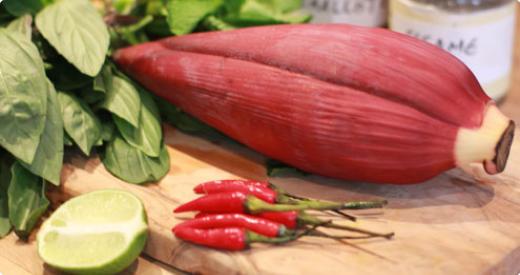
Ho Chi Minh city, made famous as Saigon, the former capital under French colonialism with Broadway musical Miss Saigon , is home to the vibrant and colourful cuisine of southern Vietnam. As a country, Vietnam can be described as two great rice baskets hung on either end of a carrying pole – in the middle is Central Vietnam and on the ends, North and South Vietnam. Fresh herbs, garlic and shallots, often sweetened with coconut milk characterise dishes in the South, while typical Vietnamese flavours such as fish sauce, prawn sauce and lime are less intense than can be found in the North.
Vietnamese cuisine reflects its geography and history. Centered by the fertile Mekong Delta, rice is a more popular staple food than noodles. However, noodles never completely leave Vietnamese cuisine – rice vermicelli can be found in phan thiet spring rolls, along with shiitake mushrooms, fish and sprigs of fresh cilantro. Southern abundance of fruit and vegetables can often be seen in the slices of mango in salads and many appetisers or the pineapple dipping sauce on the side.
The liberal use of seasoning herbs, found more in the more welcoming, wetter and warmer climate of the South, is a strong characteristic of Vietnamese cooking. They can be divided into 2 categories: those that are eaten raw and those than are cooked. For example, Chinese chives are usually harvested and eaten in large bunches stir-fried with pork and shrimp. Verdant Vietnamese balm, added fresh to goi cuon or rice paper spring rolls, lend a unique lemon verbena-like quality. The ability to personally add fresh herbs is integral to the complex layering of flavours in the cuisine – as well as lending the ability to choose a more personal taste when eating.
Vietnam is a country unique in its influences from a variety of different cultures: French, Chinese, Indian and Thai. Influences from Thailand can be seen in the adoption of mango sticky rice and Thai hotpot, both of which are very popular party foods in Ho Chi Minh City. With Ho Chi Minh city the old capital under French colonial rule, it is no surprise that the French influence is especially strong here. Banh mi , or the baguette sandwich, is typically eaten with sliced meat or pâté, with Vietnamese pickled carrots and fresh herbs tucked alongside it. Vietnamese coffee, brought in by the French in the 1800s, is a unique incorporation of French culture into Vietnamese culture. Now Vietnamese coffee is a staple on every menu and partly why Vietnam earns its nickname, “Paris of the Orient”.
Ho Chi Minh city has enjoyed over 35 years of peace with the introduction of doi moi , or independence for private businesses from its nominally Communist government, following the decades of unrest in the 20th century. Nowadays, it is a fast developing economical and financial hub of Vietnam, attracting migrants from different provinces. Vietnamese cuisine is constantly changing, and with the introduction of different cultures from all over the world, what might Vietnamese cuisine evolve into next? We invite our readers to comment.









